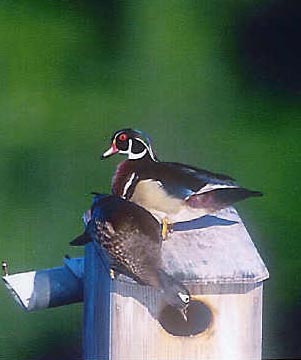
   |
 |
|
|
Duck Houses
|
|||||||||||||||||||||||||||||||
 Coveside Bufflehead Duck House
Coveside Bufflehead Duck House
The Bufflehead, with its striking white sides and white patch on its head, is smaller than most cavity nesting ducks.Dependent on nest boxes, this house is ideal due to the scarcity of holes excavated by a large woodpecker or flicker. RANGE: Breeds in Alaska east to western Quebec, and south in mountains to Washington and Montana. Winters in southern U.S., south to Mexico, Gulf Coast and northern Florida. HABITAT: Nests on wooded lakes and ponds; winters mainly on salt bays and estuaries. (17-3/4"h x 9-1/4"w x 11"d) |
 Coveside Common Merganser Duck House
Coveside Common Merganser Duck House
This house provides a perfect nest box for mergansers that normally nest in tree cavities. Positioning a house on a pole in the open water provides extra protection from predators. RANGE: Breeds across Canada from eastern Alaska, Manitoba and Newfoundland south in mountains to California, northern New Mexico, Great Lakes and northern New England. Winters south to northern Mexico and Georgia; also in Eurasia. HABITAT: Breeds on wooded rivers and ponds; winters mainly on lakes and rivers, occasionally on salt water. (24-1/4"h x 11"w x 13"d) |
 Coveside Goldeneye Duck House
Coveside Goldeneye Duck House
Unable to excavate their own cavities, goldeneyes are in constant search for good nesting sites. With a larger entrance hole than the Wood Duck House, this box comes with wood chips and a ladder to provide an ideal place for goldeneyes to lay their eggs. RANGE: Breeds in Alaska and across Canada to Newfoundland and the Maritime Provinces, south to mountains in Montana and Great Lakes. Winters in much of U.S., wherever water is open; also in Eurasia. HABITAT: Breeds on wooded lakes and ponds; winters mainly on coastal bays and estuaries. (24-1/4"h x 11"w x 13"d) |
 Coveside Small Wood Duck House
Coveside Small Wood Duck House
"Dump nesting" occurs when a number of females lay eggs in a single house, which sometimes results in clutches with over 70 eggs. Mississippi State University did a study of Wood Ducks in an effort to reduce this problem. A smaller nest box was designed and "dump nesting" was reduced. Although fewer ducklings are fledged from each box, the survival rate is improved and the cost per fledgling is less. This box comes with a wire ladder and nesting chips, and the front opens for observation and cleaning. RANGE: Breeds from British Columbia south to California, and from Montana east to Nova Scotia, and south to Texas and Florida; absent from Rocky Mountains and Great Plains. Winters near Pacific Coast north to Washington, and to New Jersey in East, rarely further north. HABITAT: Nests beside wooded rivers and ponds. Visits freshwater marshes in late summer and fall. (17"h x 7-1/2"w x 15"d) |
 Coveside Wood Chips Nesting Material
Coveside Wood Chips Nesting MaterialNesting Material. Gallon size. |
 Coveside Wood Hooded Merganser Duck House
Coveside Wood Hooded Merganser Duck House
Coveside's Wood Duck House opens two ways for observation and cleaning, and has an internal ladder for the duckings to climb out. Mother calls ducklings to the protection of the open water at age one day. RANGE: Breeds from British Columbia south to California, and from Montana east to Nova Scotia, and south to Texas and Florida; absent from Rocky Mountains and Great Plains. Winters near Pacific Coast north to Washington, and to New Jersey in East, rarely further north. HABITAT: Nests beside wooded rivers and ponds. Visits freshwater marshes in late summer and fall. (24-1/4"h x 11"w x 15"d) |
|
Ads by Google |

Home
Page |
Product Review Page | Help
 Woodside Gardens
The Registry of Nature Habitats
Woodside Gardens
The Registry of Nature Habitats 
 1999 -
1999 -
All Rights Reserved
Last Updated:
